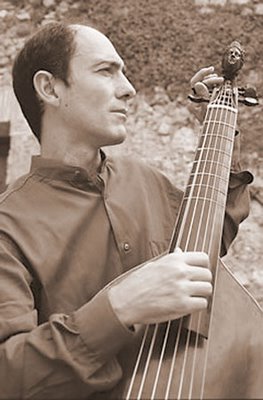Antoine Forqueray, Pièces de Viole avec la Basse Continue, Paolo Pandolfo et al. (re-released February 27, 2001) |
Improvisando (2006) Bach, Cello Suites (2001) |
Perhaps the viol and its ultra-subtle, complex music were too strongly associated with the court of Louis XIV, whom Forqueray served for much of his life, continuing in positions at court and royal chapel until his death. He never published any of his music, and all that remain from a posthumous collection published by Forqueray's son are 32 pieces gathered loosely in 5 suites, all of them presented in this set. That includes three of the pieces by Forqueray's son added to the third suite, but not the handful of other pieces attributed to Forqueray père in other anthologies. Indeed, some experts suspect that all of the music in the collection is actually by Forqueray's son, perhaps elaborations of pieces his father taught him. Forqueray fils (Jean-Baptiste Antoine, 1699-1782) dedicated the collection, in his father's name, to his own patron and then 20-year-old viol student, Madame Henriette de France (1727-1752), second daughter of Louis XV, who was shown playing her viol in a portrait by Jean-Marc Nattier.
The music is notated in the collection with the viol part on a single staff, always accompanied by a part for basso continuo, with figures. The recordings were made at two sessions, in 1994 and 1995, with various combinations of four other players covering the continuo part. In addition to Pandolfo on his 17th-century viol made by Nicolas Bertrand, a second bass viol, played by Guido Balestracci, sustains the bass line. The harmonies are filled in by Guido Morini (harpsichord), as well as Rolf Lislevand and Eduardo Eguez (on either theorbo or Baroque guitar). In one case, the pretty evocation of a mandolin in the second suite, there are guitars only and no harpsichord.
 Paolo Pandolfo, viola da gamba |  Madame Henriette de France by Jean-Marc Nattier (1685-1766) |
The pieces are mostly named after people of characters, seeming to underscore their nature as volatile (Forqueray himself in the first suite), irrepressible (La Leclair in the second suite), affectionately grand (Couperin in the first suite, a return tribute for that composer's piece, La Forqueray), gentle (La Borde, who complimented the harpsichord playing of Forqueray's daughter-in-law), pompous (La Regente in the third suite), or pensive (La Du Vaucel in the third suite). The three pieces which Forqueray fils admitted were his own sound cut from different cloth, especially La Angrave in the third suite, which has a number of unusual progressions that do not sound that harmonious. Although the fifth suite is the most virtuosic, the pieces of the fourth suite please the most, from a tragically morose sarabande (La D'aubonne), through a neurotically oscillating La Sainscy, to two movements evoking the melancholy bells in the Parisian suburb of Passy. The second version, performed only by the two bass viols (a sonority used also in the sarabande of the fifth suite), is a particularly somber and austere moment in this generally lively recording.
Glossa GCD 2K0401
No comments:
Post a Comment